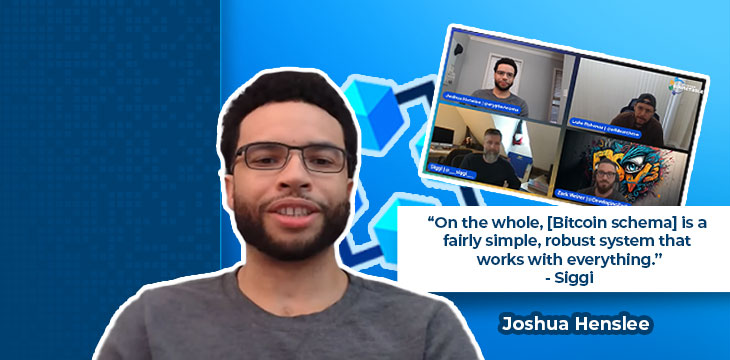
|
Getting your Trinity Audio player ready... |
Joshua Henslee recently hosted a CoinGeek Roundtable discussing open social protocols on Bitcoin. He was joined by Luke Rohenaz, Zach Weiner, and Siggi.
Introducing the guests
Luke Rohenaz is the founder and CEO of TonicPow. He has been involved in Bitcoin for a long time. Rohenaz started TonicPow after the first official Bitcoin Association hackathon and has developed a strong interest in open social protocols.
Zachary Weiner is the founder of VXPASS. He’s been a software engineer in the blockchain space for six years now. He has been involved in the BSV ecosystem since 2020 after trying Ethereum and other blockchains. He’s now focused on consumer applications built on top of Bitcoin.
Siggi has been a long-standing software developer in Bitcoin since the early days. In the last three years, he has been trying to focus on Bitcoin development exclusively. He developed Honā with George Siosi Samuels and worked on TonicPow and Jungle Bus.
What are open social protocols?
Henslee kicks off the main part of the roundtable by asking Rohenaz what open social protocols are. He characterizes them as a “set of rules we use to structure data so we can put it on-chain so that any app can consume and write that data the same way, facilitating interoperability.”
He elaborates that open protocols are not limited to social use cases. They go much further, and using Bitcoin as a database to facilitate interoperability is a huge use case that can apply to almost every industry. Any time society needs immutable records or a data set, that’s where this sort of thing can fit it, he says.
Weiner echoes that while social protocols will guide this conversation, we shouldn’t limit ourselves to that. “The openness is what drives adoption,” he says. One of the most powerful things about the protocol is that you can just build on the data that’s already there, he remarks.
Siggi agrees with what both Rohenaz and Weiner have said. He adds that Bitcoin can act as a secure distribution network. He states that getting all of the same data from anywhere is very exciting.
What is the Bitcoin schema?
“Bitcoin schema is designed to be a wide net,” Rohenaz says. “We realized we need definitions for the way we put data on-chain. We’re starting with social stuff, and so we defined social actions such as a like, a host, adding attachments, etc.” Rohenaz again emphasizes that this is not limited to social media, so there was a need to allow for developing other use cases.
Weiner mentions he had to go through other protocols first, and there are tradeoffs in everything, including which protocols to use on BSV. He views the schema as the foundation of a toolkit. Different people will require different toolkits for other jobs they want to do. He sees it as the beginning steps to realizing some of the technical dreams Bitcoin had from the beginning.
Siggi talks about implementing some of the elements of Bitcoin schema in developing apps. He says that the need for standardization was strong, and he credits it with creating greater interoperability.
“On the whole, it’s a fairly simple, robust system that works with everything,” he says.
Why put social interactions on a public blockchain?
Henslee asks why we’d even want to put social interactions on a public blockchain in the first place.
Rohenaz says he gets why people think it makes no sense. Still, he points to the recent information from Twitter about censorship, shadow-banning accounts, data curation, and more as an example of why things should be on the blockchain.
Corruption is the problem at the heart of all of this, and he says Bitcoin removes that control over data, similar to what it does for money. Even if big companies don’t manipulate the data they possess, they could, and that’s reason enough to do something about it.
Weiner says that while he accepts censorship resistance is essential, he also says there are clear and legitimate reasons to censor some things. To him, it’s less about the ability to resist censorship, but the openness of the protocol ensures that if the tools he uses become corrupted, he can take up, leave, and use other tools.
Siggi answers why we should put things on chain with “why not?” He points out that most tweets are archived immediately anyway, so the option to delete them isn’t an issue. He’s up for everything being expressed up until the point where it is illegal. Speaking of which, if a product like Jungle Bus decided to delete something because it is illegal, anyone who wanted to retrieve it could still go directly to the blockchain.
Speaking about the sort of data we should put on the blockchain, Siggi says he doesn’t care as long as the fees are paid. In other words, there’s no such thing as spam. If the miner accepts the fee and agrees to process the data, that’s all there is to it.
Does Twetch use open social protocols?
Rohenaz addresses this question, saying it’s a bit of a hybrid. A developer added Magic Attribute Protocol to some of the elements in the back end of Twetch. However, there are certain things that aren’t using it.
“I would expect that the largest social network would not want to participate in this,” he says, noting how it isn’t in the interest of Twetch to lean into this right now. In effect, it’s sharing your network effect. There has to be a fair value exchange for it to be in the company’s interest.
Siggi says they are not using open social protocols in the way he’d ideally like to see. He says this is a “bit of a shame,” saying they risk turning into a closed system like Twitter. He understands that they want to keep their piece of the pie, but they have the potential to make the pie bigger by being more open.
How easy would it be for the current social media powers if they wanted to migrate to this protocol?
“Stupid easy,” Rohenaz jokes. Weiner follows up by saying that they could just update so that it commingles with their existing platform’s data. The user wouldn’t even know the difference.
Rohenaz outlines the benefits of sharing all of the data to the blockchain, including links back from other applications. In a sense, this becomes a way of advertising.
Henslee says that, given how quickly the four participants of this roundtable implemented much of this, imagine how quickly and effectively big companies with lots of capital could implement it.
How do open social protocols benefit musicians, artists, and content creators?
Rohenaz takes this first, referencing Jamify, an NFT marketplace for musicians he pioneered. This uses orderlock, which is similar to an open social protocol.
The fact that artists can put these NFTs on Bitcoin and show up on Jamify, and 1,000 other sites, gives them direct access to distribution, which is what they don’t have now. Right now, they need distributors, and that costs them revenue. This could apply to everything in the future.
“There’s a lot of room for new products and ideas,” Rohenaz says.
Weiner states it’s also great for curation. Instead of going to Apple or Spotify, he can search directly on the blockchain for music he might like. Better yet, he can subscribe to a curation service that creates playlists and curates music he’s likely into. This opens up new revenue models and disrupts the old way of doing things.
Rohenaz says that, right now, if he wants to watch something, he searches on Google first to see which streaming service he’ll need to use to access the content he wants. This is an annoying problem that open protocols can change.
Siggi notes that we have to build better products than what already exists. Most people don’t care whether something is built on a blockchain or an open protocol; a fantastic user experience is required to bring them in.
How do you see mass adoption taking place? Is social popularity important for all of these apps?
Siggi says that giving users a pleasant experience is the key. There are very few serious barriers to entry, and the fees are low, so there are no excuses. It’s all about creating great applications.
Watch: The BSV Global Blockchain Convention panel, Entertainment, Sports & Blockchain

 11-21-2024
11-21-2024


